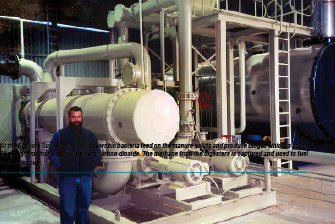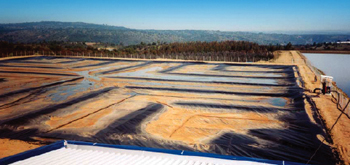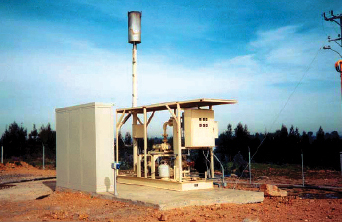
Chilean hog producer Agricola
Super has gone big with its manure management program, installing eight
digesters, and it has reaped the benefits in reduced odor complaints
and marketable greenhouse gas-reduction credits.
Chilean hog producer Agricola Super has gone big with its manure management program, installing eight digesters, and it has reaped the benefits in reduced odor complaints and marketable greenhouse gas-reduction credits.
With the installation of eight covered lagoon digesters over the past five years, Chilean hog producer Agricola Super Ltd has solved many of its manure management problems, while at the same time being rewarded for the environmental benefits produced.
“They saw that it doesn’t hurt, it works fine and they get paid for it,” says Mark Moser, an agricultural engineer and president of RCM Digesters Inc, of Berkeley, California.
 At the Agricola Super operation, anaerobic bacteria feed on the manure solids and produce biogas which is about 60 percent methane and 40 percent carbon dioxide. The methane from the digesters is captured and used to fuel boilers. At the Agricola Super operation, anaerobic bacteria feed on the manure solids and produce biogas which is about 60 percent methane and 40 percent carbon dioxide. The methane from the digesters is captured and used to fuel boilers. |
The eight systems, designed by RCM, handle the effluent from about 700,000 hogs annually near Santiago in central Chile. Not only has treatment greatly reduced the odor and fly complaints the farms used to receive from neighbors, but it also has significantly reduced methane emissions into the atmosphere. In return for its $7.5 million investment, Agricola Super Ltd (or Agrosuper as it’s commonly known) of Rangagua, Chile, is able to sell greenhouse gas-reduction credits comparable to the amount of methane it used to emit but is now captured.
Using anaerobic digestion to treat manure is more common outside the United States than within the country, Moser says. Most systems involve a vessel that holds manure long enough at a relatively constant temperature to promote high growth rates of methane-producing bacteria. While initial designs used concrete tanks, subsequent systems were built around covered, heated lagoons, making them more economical, he adds.
RCM designed its first heated, covered, continuous-mix lagoon digester for Apex Pork in Rio, Illinois, in 1998. The Illinois finishing operation was seeking solutions to odor problems from both its stored manure and field-applied manure. “It validated the design because it’s a very inexpensive design,” Moser says. “Classically, we have used concrete tanks. But we needed a gas-production vessel that was inexpensive to build and operate.”
In addition, Moser says RCM designed complete mix digesters for two Japanese hog finishing operations with 21,000 and 30,000 head, showing that the Berkeley engineering firm could handle larger scale projects.
Moser says Agrosuper contacted him about the possibility of RCM designing a similar, but much larger, treatment system after he made a presentation on manure management in Mexico City in 2000. After soliciting bids worldwide, Agrosuper hired RCM to design a covered, complete-mix, heated lagoon digester for the 120,000-head-capacity Peralillo Farms, an all-in, all-out hog finishing facility.
Moser smiles when he says the first Agrosuper digester project didn’t involve a timeline, but the seven subsequent digesters RMC has designed for the Chilean hog producer have.
“The permitting agencies had to be educated on what’s a digester. How does this fit? What is this going to do for us?” Moser says. “We had to explain to the permitting agencies that we’re looking for better manure management.”
Of the 120 buildings within the Peralillo operation, 90 were flush-manure systems, whereas 30 featured pull-plug manure collection. All of the waste drained into a shallow storage lagoon that was about 10 feet deep but had about 88 acres of surface area.
Neighbors and workers complained about the odor. When the farm pumped the effluent onto nearby fields during the growing season, large areas of the lagoon beach were exposed, serving as a breeding ground for flies.
RCM designed a 100- by 100-meter by seven-meter deep lagoon into which all of the effluent flows. All of the flush buildings are washed down daily with fresh water, which flows to collection tanks and is pumped to the digester.
Two to three pull-plug buildings are emptied each day on a rotating schedule into a transfer tank. Liquid from the tank is pumped to the digester, and flows vary from 900 to 1,800 cubic meters daily.
The lagoon, which can hold about 20 days worth of manure, is lined with 60-mil-thick plastic. Covering the lagoon is a bank-buried insulated floating cover constructed of 60-mil-thick plastic.
Much of the equipment, such as the pumps, heat exchangers and propeller mixer, had to be imported from the United States. Other materials, such as plastic, were sourced locally.
“Once we educated the locals on how to build what we wanted, they did a quality job,” Moser says.
A 100-horsepower ITT Flygt International propeller mixer, which is tied to a computerized timer, periodically agitates the effluent. Anaerobic bacteria feed on the manure solids and produce biogas, which is about 60 percent methane and 40 percent carbon dioxide. Methane from the digester is captured and used to fuel a boiler. Although fluctuations in the hog population affect biogas production, it averages about 17,100 cubic meters per day.
 The eight covered lagoon digesters handle the effluent from about 700,000 hogs annually. Treatment has greatly reduced the odor and fly complaints that the farms—which are located near Chile’s largest city, Santiago—used to receive from neighbors. The eight covered lagoon digesters handle the effluent from about 700,000 hogs annually. Treatment has greatly reduced the odor and fly complaints that the farms—which are located near Chile’s largest city, Santiago—used to receive from neighbors. |
Through heat exchangers, the covered lagoon is kept at about 35 degrees Celsius, but the temperature can vary up to five degrees C. During the winter, about 30 percent of the methane goes toward heating the lagoon, with the excess flared off. During the summer, when ambient temperatures keep the lagoon at optimum temperatures, the boiler will be off for weeks, Moser says.
Depending on the time of year, the effluent stays in the digester 20 to 40 days before being pumped to storage, Moser explains. Biological oxygen demand is reduced by 90 percent.
The digester was started over a four-month period ending in November 2000. Flare operation began in late December with 150,000 cubic feet of biogas daily.
The system was running well as the pig population was brought up to capacity. Even during the coldest periods, the digester maintained optimum temperatures. Although a computer controls the digester, Moser says an operator oversees the system and checks readings.
The total system cost about $1.2 million. While construction costs were about 60 percent of what they would be in the United States, the savings was offset by the increased costs of shipping and paying import duties on equipment, such as pumps, Moser says.
The capital cost is about $10.06 per pig capacity. Assuming the system lasts 15 years, there are no interest charges and if 2.5 cycles of pigs can move through annually, the per-pig cost is 27 cents. Operation costs add an additional 25 cents per pig shipped.
Since the initial installation at Peralillo, RCM has designed seven other treatment facilities for the integrated Chilean hog producer. And each time, the parties become more comfortable working together. “As we learn more about them and they learn more about us, we change minor items, like building layout,” Moser says. “It’s a lot easier. Everyone now has become accustomed to the local conditions.”
Agrosuper has two different types of hog operations. Female hogs are housed at sow farms, where they are bred and farrow. The pigs typically stay with the sows for about three weeks before being moved to the finishing farm. For the next approximately four months, the hogs are grown out to market weight. The sow farms house much fewer head than Agrosuper’s finishing operations. One sow farm, for example, involves about 36,000 head whereas one of Agrosuper’s larger finishing farms houses about 240,000 head annually.
 Excess methane at the Agricola Super operations is flared off (right). Because the company has been able to reduce the amount of greenhouse gas emitted into the atmosphere the company receives carbon trading credits, which can then be sold to other industries. Excess methane at the Agricola Super operations is flared off (right). Because the company has been able to reduce the amount of greenhouse gas emitted into the atmosphere the company receives carbon trading credits, which can then be sold to other industries. |
The effluent coming from the sow farms is diluted and doesn’t contain enough volatile solids to fuel the methane-producing bacteria. So Moser says RCM designed unheated covered lagoon digesters to handle the waste from these facilities.
Effluent from the finishing farms is much higher in solids, ranging from about three percent to 10 percent, which is enough to support methane-producing bacteria. For three of the four finishing farms, RCM designed complete-mix heated, covered lagoon digesters, he says.
The fourth finisher currently uses an unheated digester, but Moser says the facility isn’t nearly at capacity. Once it fills, he expects it to convert to a heated digester.
Some of the operations use the stabilized effluent to fertilize corn or eucalyptus. But others don’t have the land on which to apply the waste. So Moser says they use pushed-advanced waste treatment that involves a dissolved air flotation system to recover phosphorus.
Of the 3,000 cubic meters of waste water produced daily, only two dumpsters worth of solids remain after anaerobic and aerobic treatment, “which is pretty good,” Moser says.
Since 2000, Agrosuper has invested more than $7.5 million to build the eight digesters. Because the projects reduce the amount of greenhouse gas emitted into the atmosphere, the hog producer receives carbon trading credits under the 1997 Kyoto Protocol. From five of the projects alone, Agricola is expected to reduce the amount of greenhouse gas emitted by 400,000 metric tons of carbon dioxide equivalent annually from 2004 to 2012.
The credits can be sold to other greenhouse gas producing industries as a way to mitigate their emissions and meet goals set by the Kyoto Protocol. In a 2004 deal, Agricola Super sold credits worth 1.75 million metric tons of greenhouse gas emissions to Calgary, Canada-based power producer TransAlta Corp for $9 million. In addition, Tokyo Electric Power Co will purchase credits from Agricola worth two million metric tons of greenhouse gas over a nine-year period from 2004 to 2012. The price was not disclosed.